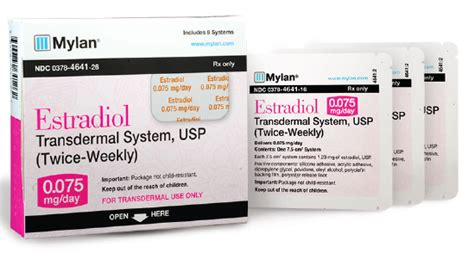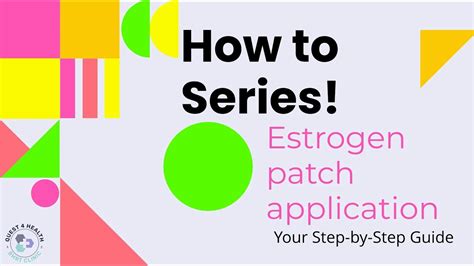Intro
Discover the 7 estrogen patch side effects, including hormonal imbalances, skin irritation, and breast tenderness, and learn about menopause treatment alternatives to minimize risks and symptoms of estrogen therapy.
The use of estrogen patches has become a common practice for women going through menopause or experiencing hormonal imbalances. These patches are designed to release a steady dose of estrogen into the bloodstream, helping to alleviate symptoms such as hot flashes, night sweats, and mood swings. However, as with any form of hormone replacement therapy (HRT), there are potential side effects associated with estrogen patches. Understanding these side effects is crucial for women considering this treatment option.
Estrogen patches work by mimicking the natural estrogen produced by the body, which decreases significantly during menopause. By supplementing this hormone, women can experience relief from menopausal symptoms, improved bone density, and a reduced risk of osteoporosis. Despite these benefits, it's essential to be aware of the potential risks and side effects, ranging from mild and temporary to more severe and long-lasting.
The decision to use estrogen patches should be made after careful consideration and consultation with a healthcare provider. This is particularly important for women with a history of certain medical conditions or those who are at increased risk for specific health issues. By weighing the benefits against the potential side effects and discussing individual concerns with a doctor, women can make informed decisions about their health and well-being.
Common Side Effects of Estrogen Patches

Estrogen patches can cause a variety of side effects, some of which are common and may resolve on their own. These include breast tenderness, headaches, and nausea. In some cases, women may experience mood changes, such as anxiety or depression, although these are less common. It's also possible for women to notice changes in their menstrual cycle, including irregular bleeding or spotting, especially during the initial months of use.
Less Common but Significant Side Effects
While less frequent, there are more serious side effects associated with estrogen patches that require immediate medical attention. These can include signs of a blood clot, such as swelling or pain in the legs, and symptoms of a stroke or heart attack, like severe headaches or chest pain. Women should also be aware of potential allergic reactions to the patch or the estrogen it contains, which can manifest as hives, itching, or difficulty breathing.
Rare but Serious Side Effects

In rare cases, estrogen patches can lead to more severe health issues. These include an increased risk of blood clots, which can be life-threatening if they break loose and travel to the lungs or brain. There's also a heightened risk of certain types of cancer, such as endometrial cancer, particularly if estrogen is used without progesterone in women with a uterus. Additionally, estrogen therapy may exacerbate conditions like asthma, diabetes, and high blood pressure, requiring closer monitoring and potential adjustments in treatment.
Factors Influencing Side Effects
The likelihood and severity of side effects from estrogen patches can be influenced by several factors. These include the dose and duration of therapy, individual health status, and the presence of other medical conditions. Women with a history of blood clots, liver disease, or certain types of cancer may need to avoid estrogen patches altogether or use them with caution under close medical supervision.
Managing Side Effects

For women experiencing side effects from estrogen patches, there are several strategies that can help manage these issues. This may involve adjusting the dose of estrogen, switching to a different form of HRT, or adding other medications to mitigate specific side effects. Lifestyle changes, such as maintaining a healthy weight, exercising regularly, and avoiding smoking, can also help reduce the risk of more serious side effects.
Alternative Therapies
Some women may find that the benefits of estrogen patches do not outweigh the risks or that they prefer not to use hormone replacement therapy. In such cases, alternative therapies can be explored. These might include non-hormonal prescription medications for hot flashes and other menopausal symptoms, as well as lifestyle modifications and natural remedies like dietary changes, stress management techniques, and certain supplements.
Conclusion and Next Steps

The decision to use estrogen patches should be based on a thorough understanding of the potential benefits and risks. By discussing individual health needs and concerns with a healthcare provider, women can make informed choices about their menopause treatment. It's also essential to follow up regularly with a doctor to monitor the effectiveness of the treatment and address any side effects that may arise.
Final Considerations
As with any medical treatment, the use of estrogen patches requires careful consideration and ongoing monitoring. Women should be proactive in reporting any changes in their health or side effects to their healthcare provider. Moreover, staying informed about the latest research and guidelines on HRT can help women navigate their treatment options with confidence.
What are the most common side effects of estrogen patches?
+The most common side effects include breast tenderness, headaches, and nausea. Mood changes, such as anxiety or depression, can also occur but are less common.
Can estrogen patches increase the risk of cancer?
+Yes, there is an increased risk of certain types of cancer, such as endometrial cancer, especially if estrogen is used alone without progesterone in women with a uterus.
How can I manage side effects from estrogen patches?
+Managing side effects may involve adjusting the dose of estrogen, switching to a different form of HRT, or adding other medications. Lifestyle changes, such as a healthy diet and regular exercise, can also help mitigate side effects.
We invite you to share your experiences or questions about estrogen patches in the comments below. Your input can help others make informed decisions about their health. If you found this article helpful, please consider sharing it with someone who might benefit from this information. Together, we can support each other in navigating the complexities of menopause and hormone replacement therapy.
